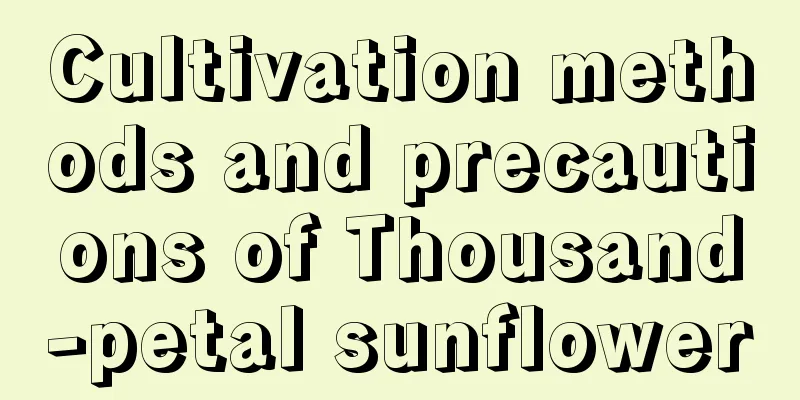Cultivation methods and precautions of Thousand-petal sunflower

Ecological habitsIt is an annual herb. The leaf tip is pointed and the whole leaf is heart-shaped. The edges of the leaves are serrated, both sides are covered with rough hairs and have long petioles. The golden yellow flowers bloom from July to September. Thousand-petal sunflower likes sunny and warm climate environment, is not adaptable to cold winter, and is suitable for growing in nutritious sandy soil. It is an easy plant to grow. Suitable for many novice flower lovers. Cultivation techniques1. Moisture. The thousand-petal sunflower has a strong tolerance to drought. The water absorption rate of the seedlings from growth to flowering is relatively low, only one-fifth of that during the growing period. 2. Nutrients. Adult Thousand-petal sunflower plants are very lush and have very developed root systems. When planting, they should be buried deep in the ground to promote the development of their root systems and to prevent the plants from being blown down by strong winds. This kind of flower needs to be supplemented with sufficient fertilizer in order to grow and bloom. When planting the sunflower in a pot, you can apply enough base fertilizer when planting, and you should also apply top dressing in time during the cultivation process. 3. Soil quality. Thousand-petal sunflower has strong adaptability and is not demanding on soil quality, so it can be grown in ordinary soil. You can choose soil with more humus. 4. Pruning. The pruning mentioned here mainly refers to branching. During the disk formation period of the sunflower, branches may appear in the middle and upper ends of its stems. At this time, these branches need to be removed in time so that the disk of the main stem can accumulate sufficient nutrients, thereby ensuring that the fruits are round and healthy. Pruning work needs to be timely. In addition, excessive density should be avoided so as not to affect ventilation and light transmission. If the plant grows too tall, you can choose to trim off some of the old leaves after the flowers are pollinated. 5. Reproduction method. The propagation method of Thousand-petal sunflower is relatively simple, which is scattering propagation. It is sown directly in early April. The conditions at this time are more suitable, and its seedlings can grow quickly. The seedlings must be thinned out in time and transplanted to the fields or larger potted plants after a certain period of time. |
<<: Cultivation methods and precautions of Emei rose
Recommend
How to care for lemons in winter
Is lemon afraid of freezing? Lemon is afraid of f...
Cultivation methods and precautions of hydroponic lucky bamboo
1. Vase Insertion A good vase can not only make t...
When is the best time to plant garlic?
Garlic is a crop with high economic value and rel...
What to do if white spots appear on chrysanthemum leaves
1. Powdery mildew 1. Reasons This disease is caus...
How to propagate aquatic plants and what to pay attention to
Aquatic plant reproduction method There are four ...
What to do if the anthurium flower withers
1. Water appropriately Improper watering will cau...
The role and use of rooting agents 8 methods and recipes for making your own rooting agents
Rooting agents can promote plant rooting. Roots a...
What fertilizer is good for gardenia?
1. Is the fertilizer requirement high? Generally ...
Is lemon cultivation profitable? Prospects and profits
Is growing lemons profitable? Lemon is quite comm...
How to care for newly bought clematis
1. Watering Clematis has a high demand for water....
How to plant dragon fruit seedlings
1. Choose a flower pot Choose a larger clay pot w...
Where is coffee suitable for growing?
Coffee growing area Generally, coffee grows in tr...
Key points of agricultural production activities in Xiaohan
The arrival of the Minor Cold solar term means th...
Does the red spider lily have leaves? What do the red spider lily's leaves look like?
1. Are there leaves? Of course, the red spider li...
Can the fortune tree be transplanted in autumn? What season is best for transplanting?
Can the fortune tree be transplanted in autumn? T...









